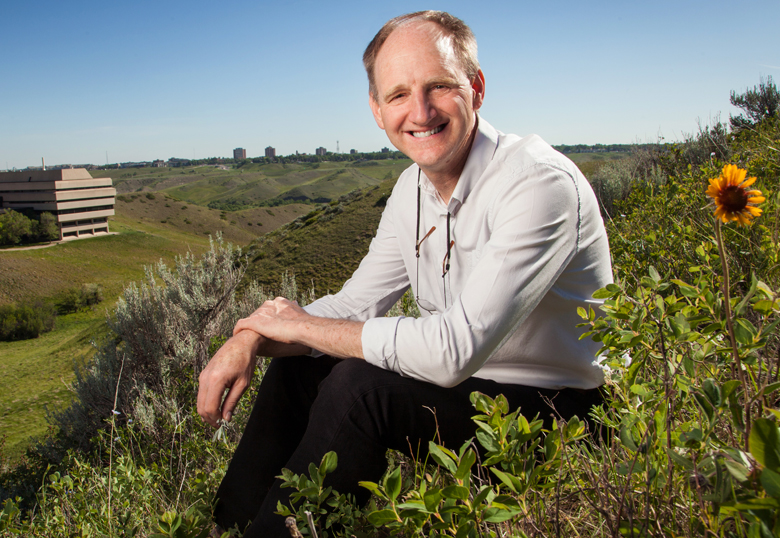Although his work is focused on one of our generation’s biggest diseases, Dr. Roy Golsteyn (BSc ’84) is honed in on the smallest of details to help bring it to its knees.
Golsteyn’s biological sciences lab has had its sights set on cancer for years and with a uniquely southern Alberta approach, is breaking new ground in finding chemicals that may lead to new cancer treatment drugs.

“Cancer is a big disease and the way I was trained, was to really find out precisely what is wrong when a disease takes over, simply because if you know what’s wrong, you can find a way to fix it,” says Golsteyn. “I’ve always loved biology and trying to understand how human cells divide. In our work, we’re testing new chemicals to see if they have anti-cancer properties and then trying to understand how cancer cells respond to them.”
On Thursday, Oct. 20, 2016, Golsteyn will present as part of the PUBlic Professor Series, detailing how his lab is utilizing the unique plant species of southern Alberta in its quest to find chemicals with anti-cancer properties. Flower Power: A Scientific Search for New Medicines in Prairie Plants begins at 7 p.m. at Lethbridge City Hall, the second of this year’s PUBlic Professor events.
“It is an astonishing fact that, even in the 21st century, we are only beginning to realize that plants from the Alberta prairies contain chemicals of medical importance,” says Golsteyn.
Born and raised in Lethbridge, he admits he never gave the coulee slopes much thought in terms of them yielding cancer-fighting chemicals. After completing his Bachelor of Science at the U of L, Golsteyn went overseas, completing his PhD studies and taking a job in the French pharmaceutical industry. He married a fellow scientist, Dr. Sophie Kernéis-Golsteyn, and they eventually made their way back to Lethbridge, he setting up shop at the U of L and his wife at Lethbridge College.
Having worked in France and gained an appreciation for the way in which they look at plants and their potential healing properties, Golsteyn began to eye the plants outside his office window in a new light. He also fell into conversation one day with a First Nations guide at Head Smashed In Buffalo Jump, on a random trip to show off the area to foreign students working in his lab.
“We started talking about how First Nations people have used these plants for years and it just seemed to click, we thought this could be interesting,” says Golsteyn, who continues to work with the First Nations community.
He’s had some early successes, namely with the Buffalo Bean, which showed very early in the testing phase that its natural compounds exhibited anti-cancer activity. His lab has now begun a new round of tests on the Brown Eyed Susan, and created a plant library for the area’s native plant species. The pharmaceutical world is taking notice.
“We’ve learned that scientifically this area is very interesting,” he says. “You can look anywhere on the planet but what makes southern Alberta most interesting is that there really is a competition in the coulees. There are very few plants out there and there once were a lot of animals to eat them, so those native plant species have developed a toxicity level that’s allowed them to survive and that’s not common. They were pushed to make chemicals so they would not be eaten and that’s the stuff that’s making this project work.”
It’s a personal quest for Golsteyn, who says he’s of the age where he knows many people who are ill and struggling with cancer. He also understands the frustration that exists in the public sphere as years of research have been devoted to finding cures for the various forms of the disease.
“We are making progress, we really are,” he says passionately. “I’m familiar with the frustration though. I think at times we oversell the research in our labs but at the same time, there’s a huge pressure to oversell it. You have to get out there and say your research is awesome so that you can keep working on it and I think people are getting frustrated with that.”
Golsteyn says great strides have been made in eradicating the disease, specifically in forms of leukemia, but that much more work needs to be done.
“The successes that are out there, they’re from people doing very careful, good science. That’s what we’re doing too,” he says. “We’re not saying just take this miracle plant and it’ll work. We’re saying there are chemicals in this plant that are very interesting, they’re new, we’re running them through some very interesting tests and seeing what happens. But I’m very optimistic.”
Golsteyn speaks with conviction, tinged with hope, that the good science he was trained to perform will yield the results he, and everyone affected by this disease, desire.

